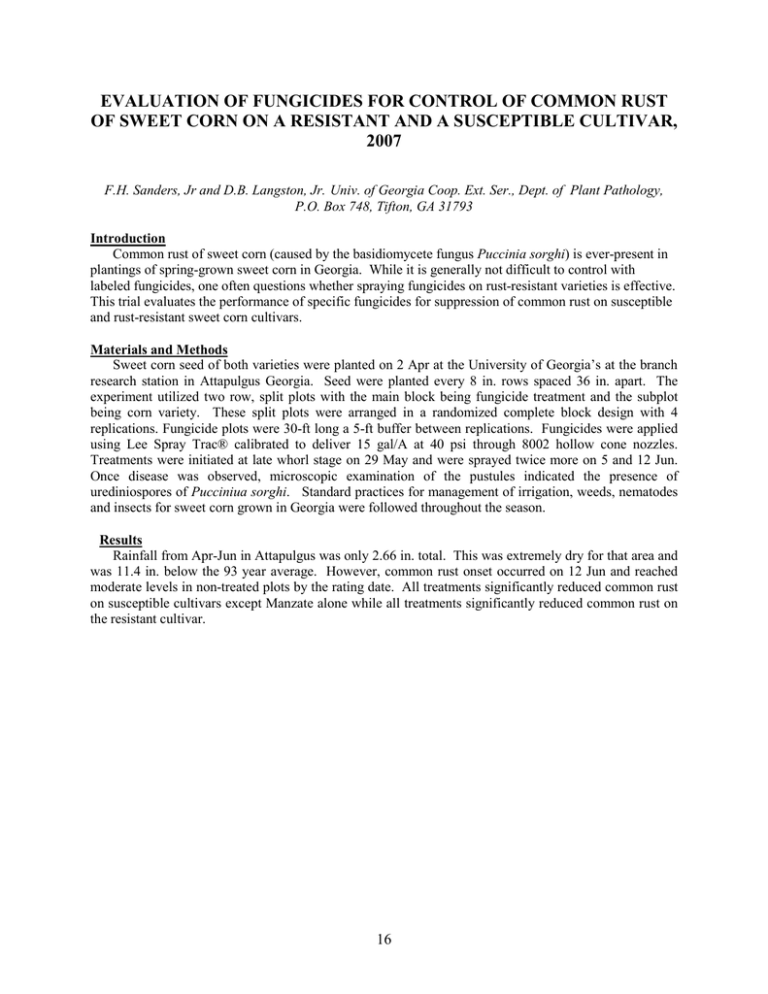EVALUATION OF FUNGICIDES FOR CONTROL OF COMMON RUST
advertisement

EVALUATION OF FUNGICIDES FOR CONTROL OF COMMON RUST OF SWEET CORN ON A RESISTANT AND A SUSCEPTIBLE CULTIVAR, 2007 F.H. Sanders, Jr and D.B. Langston, Jr. Univ. of Georgia Coop. Ext. Ser., Dept. of Plant Pathology, P.O. Box 748, Tifton, GA 31793 Introduction Common rust of sweet corn (caused by the basidiomycete fungus Puccinia sorghi) is ever-present in plantings of spring-grown sweet corn in Georgia. While it is generally not difficult to control with labeled fungicides, one often questions whether spraying fungicides on rust-resistant varieties is effective. This trial evaluates the performance of specific fungicides for suppression of common rust on susceptible and rust-resistant sweet corn cultivars. Materials and Methods Sweet corn seed of both varieties were planted on 2 Apr at the University of Georgia’s at the branch research station in Attapulgus Georgia. Seed were planted every 8 in. rows spaced 36 in. apart. The experiment utilized two row, split plots with the main block being fungicide treatment and the subplot being corn variety. These split plots were arranged in a randomized complete block design with 4 replications. Fungicide plots were 30-ft long a 5-ft buffer between replications. Fungicides were applied using Lee Spray Trac® calibrated to deliver 15 gal/A at 40 psi through 8002 hollow cone nozzles. Treatments were initiated at late whorl stage on 29 May and were sprayed twice more on 5 and 12 Jun. Once disease was observed, microscopic examination of the pustules indicated the presence of urediniospores of Pucciniua sorghi. Standard practices for management of irrigation, weeds, nematodes and insects for sweet corn grown in Georgia were followed throughout the season. Results Rainfall from Apr-Jun in Attapulgus was only 2.66 in. total. This was extremely dry for that area and was 11.4 in. below the 93 year average. However, common rust onset occurred on 12 Jun and reached moderate levels in non-treated plots by the rating date. All treatments significantly reduced common rust on susceptible cultivars except Manzate alone while all treatments significantly reduced common rust on the resistant cultivar. 16 Evaluation of fungicides on common rust of sweet corn cultivars. Common Rust Rating 21 Jun1 Sugar Twist (susceptible) Providence(resistant) Treatments, rate/A Amistar 80WG, 3.0 oz Bravo Weatherstik 6SC, 1.5 pt ...............................................1.3 Quilt 200SE, 14.0 fl oz ...........................................................1.5 Absolute 500SC, 5.0 fl oz + Induce, 1 pt/100 gal ...................1.8 Tilt 3.6EC, 4.0 fl oz ................................................................1.9 Amistar 80WG, 3.0 oz Manzate 75DF, 1.5 lb..............................................................2.0 Absolute 500SC, 5.0 fl oz .......................................................2.2 Absolute 500SC, 6.0 fl oz .......................................................2.2 Headline 250EC, 6.0 fl oz .......................................................2.4 Tilt 3.6EC, 4.0 fl oz Bravo Weatherstik 6SC, 1.5 pt ...............................................2.5 Amistar 80WG, 3.0 oz ............................................................2.7 Bravo Weatherstik 6SC, 1.5 pt ...............................................3.5 Tilt 3.6EC, 4.0 fl oz Manzate 75DF, 1.5 lb..............................................................3.5 Stratego 250EC, 10.0 fl oz ......................................................3.8 Manzate 75DF, 1.5 lb..............................................................4.3 Non-treated check ...................................................................5.8 1 e2 e e e 1.0 1.0 1.4 1.0 c c bc c de de de c-e 1.3 1.4 1.3 1.4 c bc c bc c-e b-d b-d 1.4 bc 2.0 bc 2.0 bc b-d bc ab a 2.0 2.0 2.4 3.5 bc bc b a Common rust ratings used a 0-10 scale where 0=no rust on the canopy above the ear leaf and 10=100 percent leaf area covered in pustules on foliage above the ear leaf. 2 Means in columns with letter(s) in common are not significantly different according to Fisher’s Protected LSD test at P=0.05. 17



